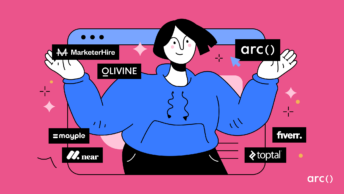The demand for skilled Scrum Masters or Agile Coaches continues to rise as more and more organizations are looking for ways to enhance project delivery times and improve their speed to market. Given the role is so pivotal to setting the tone for how a company functions, it’s crucial to get the hiring right.
As a hiring manager or technical recruiter, you’re also competing for the best talent against top companies — companies with global cachet, name recognition, and impressive pay and benefits packages.
How do you find skilled, talented, and performance-oriented Scrum Masters that are right for your company with all of the odds stacked against you?
The answer might surprise you.
It’s simply by writing a Scrum Master job description that’s clear, compelling, and relevant!
A well-written job description can:
- Make it super-clear what you’re looking for in your candidates.
- Make your vacancy and company both seem exciting and inviting so that more qualified candidates apply.
- Make it easier for the right type of candidates to reach out to you while helping you filter out the wrong ones.
Job description writing is a skill that gets better with learning and practice. Even if you’ve written dozens of JDs for Scrum Masters in the past, you’ll still find tips in this guide that can help you improve your visibility, get more quality candidates, and make the sourcing process hassle-free and more efficient.
Up next, we provide everything you need to create a highly effective job description, including:
- Our Scrum Master job description template, which you can use straight away or customize for your specific needs.
- A step-by-step guide that tells you how to write your own Scrum Master job description from start to finish.
- Examples from real-life job ads you can use for inspiration and reference.
- Practical tips and advice to help your JD stand out and magnetize the ideal candidate.
Let’s get started!
Looking for top talent fast? See how Arc can help you:
⚡️ Find developers, designers, marketers, and more
⚡️ Freelance or full-time remote + fully vetted
⚡️ Save up to 80% with global hires
Hire top talent with Arc risk-free →
Sample Scrum Master Job Description
Before we get into the nitty-gritty of writing a winning job description for Scrum Master positions, here’s the job description template we promised!
Use this template as an example to work off of, or copy, paste, and edit it to your needs.
Scrum Master, Agile Coach (Remote) About Us Focus Tech Solutions is a New York City-based startup taking personal productivity to the next level with our array of applications and research into secure neural implant technologies. You’ll be joining a globally distributed team working on cutting-edge development with the goal of making humans more efficient and more effective. What You’ll Do As a Scrum Master at Focus Tech Solutions, you’ll promote and champion Agile methodologies. You’ll identify and remove functional impediments to ensure the sprint is completed successfully. You’ll take ownership of promoting continuous improvement across all levels of the organization while meeting project goals efficiently and effectively. You’re a passionate individual who takes pride in getting the best out of individuals and teams, creating an exciting workplace in the process. You’ll document end-user stories, manage product backlogs, and facilitate scrum team meetings inclusive of sprint planning, retrospectives, demos, and sprint reviews. You’ll also actively coach team members to enhance productivity, autonomy, and agility to react quickly to change. Responsibilities ● Collaborate with prospective global users and clients to understand and anticipate their needs and translate them into product requirements. ● Provide collaboration, facilitation, leadership, and coaching, supporting the Scrum Team and the Scrum process. ● Influence internal, remote, and vendor partner teams to operate in a fast-paced and exciting environment to enable the development and release of high-quality products. ● With your team, define the vision for the team's product, creating the product road map based on this vision. ● Manage the product backlog and prioritize these items based on changing requirements. ● Facilitate sprint planning, daily stand-ups, feedback meetings, sprint reviews/retrospectives, etc. ● Exemplify a Lean-Agile mindset through servant leadership. ● Champion and coach others in the use of the Agile software development methodology. ● Oversee all stages of product creation, including design and development. ● Development and refining of user stories for the team. ● Monitoring and evaluating product progress at each stage of the process. ● Liaising with the product team and end-users to deliver updates. ● Support changes that increase the productivity of the Scrum Team. ● Anticipate challenges, identify risks, and recommend mitigations and solutions. ● Remove impediments to team progress. Must-Have Qualifications ● Bachelor's degree in business administration, information technology, engineering, or related field preferred or equivalent combination of education and experience. ● 8-12 years of practical experience serving as Scrum Master with a solid comprehension of Agile values, principles, methodologies, and the development lifecycle. ● Ability to identify cross-team dependencies and align work optimally. ● Track progress of team performance utilizing appropriate metrics and foster adoption of a high-performing Agile culture by working closely with the Leadership team. ● Strong interpersonal/communication skills/mentoring skills/ servant leadership skills with proven ability to remove impediments from the team. ● Ability to foresee potential conflict and bring existing conflicts to positive resolution. ● Pragmatism (focus on getting the job done). Must be systematic and organized. ● Exhibits a 'can-do' mentality, while acting as a continual improvement role model. ● Problem-solving and (re-)planning abilities and the ability to meet reasonable deadlines. Nice-to-Have Qualifications ● PMP, CMC, SPC certifications. ● Past experience working in a fully remote environment. Compensation & Benefits ● Competitive base salary, $96,000 – $146,000 ● Unlimited paid vacation ● Paid parental leave ● Stock options & retirement plans ● Yearly remote work stipend ● Medical, dental, and vision insurance ● Paid gym membership and self-development courses Get In Touch! We’re a great team with a wholesome company culture emphasizing work-life balance, talking our issues out, and helping each other proactively and enthusiastically! If you want to take your engineering career to the next level while working on a team and for a company that cares about its employees and the world around them, reach out to us today!
Bear in mind — there is no single correct way to write a job description. Our JD template above runs through the most important aspects that need to go on a job description for it to be effective and appeal to quality candidates.
Update the template based on what makes sense for the company you work for and the amount of information you have on the offered position. Also, read our guide that follows to help you optimize the JD to your preferences.
Check out our entire set of tech job descriptions and choose the one which fits your hiring needs best:
- Software Engineer Job Description
- Python Developer Job Description
- Front-End Developer Job Description
- Angular Developer Job Description
- Back-End Developer Job Description
- Cloud Architect Job Description
- JavaScript Developer Job Description
- AWS Cloud Engineer Job Description
- AWS Cloud Practitioner Job Description
- AWS Cloud Architect Job Description
- Scrum Master Job Description
- Full Stack Developer Job Description
- Node.js Developer Job Description
- Cloud Engineer Job Description
- DevOps Engineer Job Description
- Web Developer Job Description
- React Developer Job Description
- Ruby on Rails Developer Job Description
- Agile Product Owner Job Description
- Agile Project Manager Job Description
- Remote Developer Job Description
Or, say goodbye to writing job descriptions altogether with HireAI. Discover top remote developers instantly without manual searching and screening. Try HireAI now!
How to Write a Scrum Master Job Description
Use the following sections as a starting point or baseline to develop your final job description. The sections are listed in the same order on most online and offline channels. However, feel free to alter the length and content to your company’s specific needs.
1. Job title
The job title always comes first, as it’s the first thing a potential candidate looks for when searching for a specific vacancy, whether it’s on a job board, like LinkedIn, Indeed, or our own one here at Arc, or the company website.
While you want to list the exact job title, you may also want to add additional descriptors that give a holistic picture of the role. At the same time, you don’t want it to be cluttered or clunky. Keep it short, concise, and to the point. Candidates may opt out of reading further if the title is meandering and all over the place. The JD can also come across as not well-thought-out, which can be a red flag for serious candidates.
A powerful job description title is super important.
Let’s look at two examples of job description titles:
Bad Example:
Scrum Master
Good Example:
Scrum Master - SAFe Nexus (Remote)
Just saying “Scrum Master” in the job title doesn’t provide the minimum amount of detail a potential candidate might need to want to read further. After all, it’s so broad.
Instead, qualify it with essentials, such as:
- A seniority level (e.g., junior, senior).
- The type of framework, if applicable (SAFe, Kanban, etc.).
- The area or sub-area of development (e.g., mobile applications, web, security).
To make it more descriptive, you can also include:
- Required technological background or certification (CSM, PMP, etc.).
- Location (e.g., remote, on-site, hybrid).
- Company name (though many job boards already include that in the search results).
- Company division (e.g., User Growth, Partnerships, Reliability).
Read More: Terminal vs Arc: Why Arc.dev is One of the Best Terminal.io Alternatives
2. About the company
As a recruiter or hiring manager, you naturally want the best-fit candidates applying for the job. But, the really great candidates with the necessary experience and skills often like to know who they’re working for. The company name, brand image, and internal culture can influence whether a potential candidate decides to complete the application process.
Avoid getting into too much detail here. A few paragraphs highlighting the products or services your company creates, the industry your company is in, and a bit about the company culture are often all that’s required.
Your goal is to get them to read further down the page. So, think about what sets your company apart. Do you have the backing of well-known VCs? Do you care about work-life balance and mental health? Has your company won prestigious awards? Do you prioritize diversity, equity, inclusion, and accessibility?
If so, mention it!
Here’s a creative Scrum Master job description example from Cisco from their job board:
#WeAreCisco, where each person is unique, but we bring our talents to work as a team and make a difference powering an inclusive future for all. We embrace digital, and help our customers implement change in their digital businesses. Some may think we’re “old” (36 years strong) and only about hardware, but we’re also a software company. And a security company. We even invented an intuitive network that adapts, predicts, learns and protects. No other company can do what we do – you can’t put us in a box! But “Digital Transformation” is an empty buzz phrase without a culture that allows for innovation, creativity, and yes, even failure (if you learn from it.) Day to day, we focus on the give and take. We give our best, give our egos a break, and give of ourselves (because giving back is built into our DNA.) We take accountability, ambitious steps, and take difference to heart. Because without diversity of thought and a dedication to equality for all, there is no moving forward. So, you have colorful hair? Don’t care. Tattoos? Show off your ink. Like polka dots? That’s cool. Pop culture geek? Many of us are. Passion for technology and world changing? Be you, with us!
Most job applicants don’t need or want to know your company’s entire history or the founders’ life stories. Especially as the first thing they read. But, in the oft chance that they do, link them to the appropriate pages (e.g., “About us,” “Mission statement,” “Meet the team”) on your company website and move on!
3. Role summary
Experienced Scrum Masters often have a sense of what’s expected of them when they’re considering applying for a new job. But as a hiring company, you want to be clear about your specific expectations in terms of roles and responsibilities, competencies, and deliverables.
Think of the role summary as a high-level overview of the job. It’s like an elevator pitch, if you will, but for a job vacancy.
Here’s an excellent example job description role summary from TechFlow, Inc. via Talent.com:
TechFlow, Inc. is hiring an Agile Coach to provide adaptive coaching and the ability to work hands-on with teams in an IT advisory role, guiding teams toward improving work and facilitating sprint planning. The Agile Coach aids in implementing agile techniques and the execution of Scrum, demonstrating a strong ability for identifying IT waste and helping teams devise streamlined solutions. They are proficient with drawing storyboards and developing IT acceptance criteria. The Agile Coach will be responsible for facilitating meetings and reviews, assisting project/program managers and departments for continuous improvement, and ensuring that agile development practices are followed and adjusted as required. They help facilitate critical recurring processes such as work replenishment, risk reviews, service delivery, operations, and strategic planning. Ultimately, the Agile Coach helps ensure that key metrics such as lead time and work-in-progress are maintained and reviewed regularly to facilitate decision-making.
Standard headings for this section are “Role summary,” “About the job,” and “Job summary.”
Read More: Toptal vs Upwork, Fiverr, Arc: Where to Find Great Freelance Developers?
4. Duties and responsibilities
Once you’ve provided the role summary, you’ll now want to go into the details of what the role entails from a day-to-day perspective.
The role summary doesn’t necessarily have to be a section separate from the role summary above. Instead, it can be a continuation of that — but make it a bullet point list to help it stand out. Mention processes the Scrum Master will be responsible for implementing, and general daily activities, at the very least.
Here’s a great example from a Scrum Master role at The Hartford via Indeed:
Responsibilities ● Supports and facilitates Scrum Teams in various functions by fostering Agile values and practices. ● Ensures team adherence to Agile principles. Provides coaching to the Scrum Team(s) on how to execute the Scrum framework. ● Acts as a role model for servant leadership. ● Organizes and facilitates ceremonies, identifies improvement opportunities to optimize velocity and quality while mitigating risk. ● Tracks and communicates the overall team progress providing visibility to stakeholders. (Retrospectives, Sprint Planning, etc.) ● Serves as a filter to remove impediments to progress as identified by the team. ● Protects the team from outside influences to ensure the team remains focused on Scrum Team priorities. ● Partners with the Product Owner to ensure the backlog items are prioritized based on business value and ready for the teams. Facilitate team for better creativity, drive innovation and tries to improve the efficiency of the development teams. ● Support Release Train Engineer, IT Lead and business to drive strategic agendas. Arranges daily stand-up meetings, facilitates/schedules meetings, demo and decision-making processes in order to ensure quick inspection and proper use of adaptation process. Matrix reporting, provides coaching/feedback to ensure team success
5. Must-have skills and experience
Known as “core qualifications,” “requirements,” “job experience,” or “what you’ll bring,” among other things, this is where you’ll list out the necessary abilities, and expertise candidates must have to be considered. Use a bulleted list here, as well.
Here’s a great example from a Vertafore job post for an Agile Coach taken from the BuiltInColarado job board:
"Must have" skills: ● Excellent written and oral communication, especially enabling visibility and transparency ● Practical team experience with Scrum, Kanban, and/or XP practices ● Continuous improvement mindset and understanding of the core tenants of Agile ● Pragmatic approach to enacting change in individuals and groups ● The ability to approach both problems and successes with open-minded curiosity
Try not to go overboard here. Don’t include skills or years of experience in this area if it’s not a certain deal breaker otherwise. Allow for some flexibility, so otherwise great candidates can come through.
Read More: Contract-to-Hire: The Flexible Remote Engineering Team Scaling Solution
6. Nice-to-have skills and experience
Like the previous section, include a list of skills and expertise the ideal candidate might possess to stand out.
Continuing from what Vertaforte asked for in the BuiltInColarado job board, here’s an example of “nice to have” skills:
"Nice to have" skills: ● Large and small group facilitation experience ● Previous Scrum Master, Agile Coach, or other coaching experience ● Experience with the Scaled Agile Framework (SAFe), or other scaling strategies ● Experience with cross-functional teams, both within development and across departments (e.g., customer support, sales, marketing, implementations, etc.) ● Project leadership & organization skills, including a little spreadsheet voodoo ● Interest in looking at data (qualitative or quantitative) and discovering the story behind the data ● The ability to engage with a group or individual and facilitate learning without directing them to a specific solution ● A background in Computer Science or related technical experience
Pro tip: Show off your company culture here, too! For example, mention they’ll get bonus points if they love dogs when you have a dog-friendly office.
7. Requirements for education or certifications
While education and certifications are great to have, focussing on paper credentials can take away your focus from what really counts – performance and results. Many otherwise high-functioning candidates may have achieved their current level of expertise through exploring non-traditional educational pathways.
But, if your company does require it, list educational qualifications or certifications by all means. Explain the lowest necessary level of education (e.g., bachelor’s degree, master’s degree) and the areas of study (e.g., information technology, computer science). Some companies can require that Scrum Masters have Scrum certifications or Agile coaching experience and other specific certifications depending on the job role.
Read More: Good vs Great Developers: How to Tell the Difference & Hire the Best
8. Working time and location
This can be a potential deal-breaker for candidates, so it’s important to mention the specifics.
Include the city where the job is located for an on-site role. However, if you will consider (or require) a remote employee or hybrid arrangement, specify the same.
Must they be within driving distance for important in-person meetings? Will you provide relocation services and assistance? Do you expect the candidate to travel to and attend industry events?
Pay special attention to time, as well — do you require prospective Scrum Masters to have a fixed schedule that matches up to your core team, or be available for a few hours daily?
If you can only hire employees who have the authorization to work in a particular country, don’t forget to mention that, either. Finally, inform applicants of any potential work outside of regular hours, such as on-call requirements or when your team is working on weekend releases.
9. Compensation, perks, and benefits
This section is pretty self-explanatory, but here are some of the standard and most-appreciated items to consider when speaking of both paid and unpaid compensation:
- Annual salary range
- Paid time off (PTO) policy
- Health coverage: medical, dental, vision, mental health, etc.
- Reimbursements for professional growth
- Referral bonuses
- Software and hardware
- Remote work office stipend
- Ownership, equity, and/or stock options
- Performance bonuses
- 401(k) & retirement savings programs
- Spending accounts: FSA, HSA, etc.
- Sick leave and bereavement policy
- Parental leave policy
- Company retreats and team bonding activities
- Subscriptions: gym membership, magazines, newspapers, etc.
- Regular social events, company lunches, and happy hours
- Tuition reimbursement
Read More: How to Build and Maintain a Distributed Software Engineering Team
10. Other job description sections to consider
The above fields that we discussed cover the most important information that’s expected in an effective job description. But sometimes, it may be to your benefit and helpful for the candidate to cover other items such as the ones we’ve listed below.
For example, you could consider:
Company culture – Many companies these days like to hire for a culture fit to ensure high employee productivity and retention rates. Experienced candidates may also want to get a sense of the corporate culture before applying. So if you’re proud of how great and inclusive your organization’s culture is, by all means, show it off! Use a paragraph or two to cover some of the highlights.
How to apply – Make use of the button provided by the job board to direct candidates to application forms. Alternatively, you can add instructions for the candidates to send their resumes and cover letters to a specific email address.
Point of contact – Additionally, you can leave your name and contact information if applicants have questions about the role before applying. It’s not only a nice touch but also a great way to get feedback on how well you’ve described the position in the job description! Opt out if you expect to get inundated with inquiries, which leaves you with little time to do anything else.
Legalese – You may be required by your local or national laws to include disclaimers about how you’ll process their data, disclosures of privacy, affirmative action plan/equal employment opportunity (AAP/EEO) statements, etc.
Our ideal candidate is – This is similar to the “nice-to-haves” section above but framed in a different, more human way. Here you can list soft skills (e.g., excellent time management, strong interpersonal skills), causes or interests you’d appreciate they’re passionate about, etc.
Employment type – Given remote and hybrid work models are common these days, it’s essential to mention the employment type. Also, indicate if it’s a contract or part-time role, etc.
Screening – Inform candidates of any required pre-employment drug tests, mandatory vaccinations, or credit checks.
Hiring process – Let applicants know what to expect in the upcoming weeks. How many steps until the final round? When should candidates expect to hear back from you, whether successful or otherwise?
Key dates – If it’s not immediately apparent, add when the job was posted and when the job ad expires. If applicable, add a starting date for the position, especially if it’s months away.
Read More: Hiring Developers Online: Freelance vs Recruitment Agencies vs In-House
You can also try Arc, your shortcut to the world’s best remote talent:
⚡️ Access 450,000 top developers, designers, and marketers
⚡️ Vetted and ready to interview
⚡️ Freelance or full-time
Try Arc and hire top talent now →
Tips for Writing a Compelling Job Description for Scrum Masters
1. Be inclusive in your job description
While usually unintentional, there are problematic words and phrases in job descriptions, particularly in the tech industry. For example, terms like ninja, best of the best, stock options, and takes risks can both attract men and turn away women. Additionally, places using lots of corporate jargon tend to imply the internal culture is an old-boys club, which will put off many great non-white and/or non-male applicants.
Inclusive language is important, so review the wording in the job title and role description for phrasing that might be unconsciously biased, if not overtly, particularly against women and people of color.
To help parse your Scrum Master job description text for discriminatory terms and to obtain inclusive alternatives, check out the free and simple Gender Decoder or the feature-rich Textio.
2. Use text formatting to make your JD easy to read
Candidates can quickly lose interest, no matter how motivated they are, if your job description for Scrum Master positions is hard to read. That can happen if you use just the one monotonous font of a single size throughout without clear or visible breaks between different sections.
Make use of text formatting features that are available on most word processing programs like MS Word or Google Docs (both free!) to format your text so that it’s clear and easy to read. Bear in mind that Google Docs doesn’t offer the breadth of features that MS Word does.
Use professional-looking fonts with varying sizes for your main title, content headings, and subheadings. You can’t go wrong with the Arial and Times New Roman fonts which are universally popular for professional documentation. Aim for sizes in the range 14-16pt for titles and headings and 11-12pt for normal text as a general guideline.
For ease of use, you can pre-assign names to each format type and apply them as needed in your word processing program, so H1 for your title, H2 for your headings, and H3 or H4 for subheadings.
Add spacing between sections. Link to the relevant pages on your website for more information. Use bulleted lists instead of paragraphs when you’re listing different aspects like responsibilities or benefits.
Read More: How to Conduct a Remote Technical Interview Successfully: 7+ Tools & Tips
3. Speak directly to your candidates
Third-person job descriptions can appear cold and uninviting. You want to use the second person singular point of view to capture the interest and engage potential candidates. Using the second person pronoun ‘you’ can help you quickly connect to applicants and establish a warm connection from the get-go.
For example, rather than saying:
"The ideal candidate for this position is…"
Use this instead:
"You'd make a great fit as our Scrum Master if you have…"
4. Include a specific instruction for when candidates apply
Towards the end of your Scrum Master job description, consider adding specific instructions for candidates as they apply. It’s a trick used by many recruiters and hiring companies to filter out applicants who don’t read the job description closely enough, which may be especially useful if you’re inundated with applications. It can also show you who’s genuinely interested.
For example, ask candidates to include the job ID number in the subject line of their email. Or, you could ask them NOT to use the apply button on the job board and instead send their docs to a designated email address. If you go with this option, add the instructions in the “How to apply” portion of the JD.
Read More: How & Why Hiring Remote Developers Builds Strong and Diverse Teams
5. End your job description with a call to action
End your Scrum Master job description with an enticing call to action, also called CTA for short. To make your CTA really pop, use action words like ‘apply’ or ‘send’. Make your CTA short, specific, and snappy, so candidates know what they need to do next clearly and quickly.
For example, you can say:
"Click the red 'APPLY' button…"
Or:
"Email your resume and cover letter to [email address]..."
Wrapping Things Up
How you write your job description for Scrum Master applicants can determine the quality and relevance of the job applications you receive for your vacant positions.
Use the template we’ve provided or develop your own using our guide above to take the guesswork out of the job hiring process and find great candidates fast!
You can also try Arc, your shortcut to the world’s best remote talent:
⚡️ Access 450,000 top developers, designers, and marketers
⚡️ Vetted and ready to interview
⚡️ Freelance or full-time








